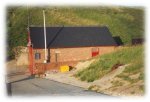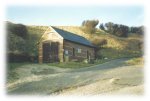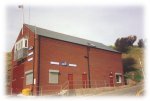 |
 |
The Flamborough Lifeboats |
 |
 |
© Simon Robson
1998-2007
Home
Services
Boats..
Pictures
R.N.L.I
Links
History..
Awards..
The Stations are Formed
This page was |
Misc. |
| Site Map Copyright |
Related |
| Before the RNLI Timeline Tragedies |
After the carnage of the 'Tenth of February Gale', the villagers of Flamborough made appeals to the Royal National Lifeboat Institution. These were supported by a report from the District Inspector of Lifeboats and lead to the stations being established in November of 1871.
As Flamborough is a headland it was decide to form two lifeboat stations, one on the north side at North Landing, and one on the south side at South Landing. The North Landing station was known as the number one station, and South Landing was the number two station. The village lies in the middle and is the same distance from both stations. The crews were formed from the fishermen.
 North Landing has a narrow entrance and has shallow scars on both sides, which during a northerly gale force the sea up into steep rolling breakers. As the weather gets worse these rollers become wider and eventually seal off the entrance. Under these conditions South Landing is sheltered and relatively calm. A southerly gale produces the opposite effect. The whole idea of two stations was that at least one lifeboat could be launched into the lee of a gale. This practice was already in use by the local fishermen who mostly had cobles at both North and South Landings.
North Landing has a narrow entrance and has shallow scars on both sides, which during a northerly gale force the sea up into steep rolling breakers. As the weather gets worse these rollers become wider and eventually seal off the entrance. Under these conditions South Landing is sheltered and relatively calm. A southerly gale produces the opposite effect. The whole idea of two stations was that at least one lifeboat could be launched into the lee of a gale. This practice was already in use by the local fishermen who mostly had cobles at both North and South Landings.
To accommodate the new lifeboats, two lifeboat houses were built. These were constructed of red brick with grey slate roofs. They were designed by Mr. C. H. Cooke, F.R.I.B.A., the Institutions honorary architect. The North Landing station cost £185 and the South Landing station cost £185 10s. The then Secretary of the Royal National Lifeboat Institution said "Substantial and well-built houses have been provide which will probably excite the admiration of those who may celebrate the centenary of the Institution". It is a testament to the builders that both houses remained standing until 1992, when the South Landing station was demolished and re-built to accommodate the new Atlantic lifeboat. The original North Landing station still remains standing today.
The North Landing station, which is now closed, remained unchanged until a slipway was constructed in 1890, at a cost of £250. The boathouse was extended and the slipway was modified in 1934 in readiness for the new motor lifeboat. An electric winch was installed at this time. Although the original South Landing station was closed in 1938 it remained in use as a store for fishing gear. This house remained in its original state until 1873, when a retaining wall was built. The wall costing £70 was to hold back the clay bank at the side of the boathouse, which had begun to slip as a result of heavy rain.
 One committee under the leadership of the Reverend J. F. Wilkinson, M.A, managed the two stations. He was Flamborough's Vicar and was appointed Honorary Secretary and Treasurer. It was decided that the boats officers would be elected by a vote of the fishermen, but this had caused some difference of opinion. The first Coxswain of the No. 1 station was voted in and was Mr. Stephenson Warcup. Mr John Fell was voted as the No. 2 station Coxswain. A crew and reserve crew were also created for each station.
One committee under the leadership of the Reverend J. F. Wilkinson, M.A, managed the two stations. He was Flamborough's Vicar and was appointed Honorary Secretary and Treasurer. It was decided that the boats officers would be elected by a vote of the fishermen, but this had caused some difference of opinion. The first Coxswain of the No. 1 station was voted in and was Mr. Stephenson Warcup. Mr John Fell was voted as the No. 2 station Coxswain. A crew and reserve crew were also created for each station.
Due to the steepness of the slipways at both stations, launching carriages proved to be impractical. Additional men were required to form launching crews, who would be required to haul the lifeboats over the beach on greased wooden skids. This method must have been extremely difficult, especially at low water. It is recorded on many occasions that launching crews often entered the water, sometimes neck high to get the boats afloat.
 The new South Landing station was built in 1992. It is still of red brick with a grey slate roof, but is larger than the original. There is now a crew room, changing area and workshop on the first floor. The crew room has a fitted kitchen area for preparing hot drinks and has a bay window that looks out over Bridlington Bay. The massive front doors are constructed of wood in an effort to keep it in the character of the original building. A gift shop and Council boating inspectors office were also incorporated into the design. A new concrete slipway was also constructed.
The new South Landing station was built in 1992. It is still of red brick with a grey slate roof, but is larger than the original. There is now a crew room, changing area and workshop on the first floor. The crew room has a fitted kitchen area for preparing hot drinks and has a bay window that looks out over Bridlington Bay. The massive front doors are constructed of wood in an effort to keep it in the character of the original building. A gift shop and Council boating inspectors office were also incorporated into the design. A new concrete slipway was also constructed.
Pictures by the late John Bates former Flamborough Lifeboat Press Officer

Designed by Simon Robson ©1998-2007
Helmsman - Flamborough Lifeboat Station